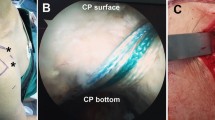Abstract
Purpose
Treatment of acromioclavicular joint (ACJ) dislocation is not encoded uniquely. Type I and II injuries are usually treated conservatively, while types IV, V and VI surgically. Controversy still exists over the treatment of type III injuries. In the operative approach, there is no agreement on the best surgical technique. Our purpose is to compare the mini-open and arthroscopic approach focusing on the evaluation of the anatomical precision of the coracoid drilling.
Methods
This is a controlled laboratory study. Ten fresh-frozen cadaveric shoulders were randomly assigned to the two techniques in order to compare them. We performed essential surgical gestures to drill the tunnel using MINAR® System (mini-open) and Dog-Bone® (ARTHREX, arthroscopic). The anatomical specimens were then subjected to CT-scan investigation. We statistically evaluated the precision of these two techniques analyzing DICOM files using two parameters. Parameter 1 evaluates the tunnel entry area on the superior side of the coracoid. Parameter 2 describes the orientation of the tunnel.
Results
There are no statistically significant differences (95% confidence level) between arthroscopic and mini-open approach about the precision in the location of the coracoid hole, regarding the entry area (p = 1.00) and the orientation (p = 0.196).
Conclusion
The evidences collected enable the orthopedic surgeon to choose equally between the two techniques in the treatment of AC joint dislocation toward precision.


Similar content being viewed by others
References
Tauber M (2013) Management of acute acromioclavicular joint dislocations: current concepts. Archives of Orthop Trauma Surg 133(7):985–995
Spencer EE (2007) Treatment of grade III acromioclavicular joint injuries. Clin Orthop Relat Res 455:38–44
Modi CS, Beazley J, Zywiel MG, Lawrence TM, Veillette CJH (2013) Controversies relating to the management of acromioclavicular joint dislocations. Bone Jt J 95:1595–1602
Nordqvist A, Petersson CJ (1995) Incidence and causes of shoulder girdle injuries in an urban population. J Shoulder Elb Surg 4:107–112
Jacobs B, Wade PA (1966) Acromioclavicular-joint injury. An end-result study. J Bone Joint Surg Am 48:475–486
Webb J, Bannister G (1992) Acromioclavicular disruption in first class rugby players. Br J Sports Med 26:247–248
Tamaoki MJ et al (2010) Surgical versus conservative interventions for treating acromioclavicular dislocation of the shoulder in adults. Cochrane Database Syst Rev. https://doi.org/10.1002/14651858.CD007429
Mouhsine E, Garofalo R, Crevoisier X, Farron A (2003) Grade I and II acromioclavicular dislocations: results of conservative treatment. J Shoulder Elb Surg 12:599–602
De Carli A et al (2015) Acromioclavicular third-degree dislocation: surgical treatment in acute cases. J Orthop Surg Res 10:13
Hootman JM (2004) Acromioclavicular Dislocation: Conservative or Surgical Therapy. J Athl Train 39:10–11
Ceccarelli E et al (2008) Treatment of acute grade III acromioclavicular dislocation: a lack of evidence. J Orthop Traumatol 9:105–108
Cho C-H et al (2014) Reliability of the classification and treatment of dislocations of the acromioclavicular joint. J Shoulder Elbow Surg 23:665–670
Coale RM, Hollister SJ, Dines JS, Allen AA, Bedi A (2013) Anatomic considerations of transclavicular-transcoracoid drilling for coracoclavicular ligament reconstruction. J Shoulder Elb Surg 22:137–144
Wang LC et al (2015) Biomechanical Evaluation of Coracoid Tunnel Size and Location for Coracoclavicular Ligament Reconstruction. Arthrosc J Arthrosc Relat Surg 31:825–830
Nowak MD, Sc D, Arciero RA, Mazzocca AD (2012) Biomechanical Evaluation of Effect of Coracoid Tunnel Acromioclavicular Joint Dislocations. YJARS 28:1230–1236
Mara G (2011) Surgical treatment of acromioclavicular dislocation with minimally invasive surgery 25:359–365
Petersen W, Wellmann M, Rosslenbroich S, Zantop T (2010) Minimally invasive acromioclavicular joint reconstruction (MINAR). Oper Orthopädie und Traumatol 22:52–61
Woodmass J et al (2015) Complications following arthroscopic fixation of acromioclavicular separations: a systematic review of the literature. Open Access J Sport Med 6:97
Luis GE, Yong C-K, Singh DA, Sengupta S, Choon DS (2007) Acromioclavicular joint dislocation: a comparative biomechanical study of the palmaris-longus tendon graft reconstruction with other augmentative methods in cadaveric models. J Orthop Surg Res 2:22
Faggiani M, Vasario GP, Mattei L, Calò MJ, Castoldi F (2016) Comparing mini-open and arthroscopic acromioclavicular joint repair: functional results and return to sport. Musculoskelet Surg 100:187–191
Rios CG, Arciero RA, Mazzocca AD (2007) Anatomy of the Clavicle and Coracoid process for reconstruction of the coracoclavicular ligaments. Am J Sports Med 35:811–817
Defoort S, Verborgt O (2010) Functional and radiological outcome after arthroscopic and open acromioclavicular stabilization using a double-button fixation system. Acta Orthop Belg 76:585–591
Taft TN, Wilson FC, Oglesby JW (1987) Dislocation of the acromioclavicular joint. An end-result study. J Bone Jt Surg Am 69:1045–1051
Author information
Authors and Affiliations
Corresponding author
Ethics declarations
Conflict of interest
The authors declare that they have no conflict of interest.
Additional information
Publisher's Note
Springer Nature remains neutral with regard to jurisdictional claims in published maps and institutional affiliations.
Rights and permissions
About this article
Cite this article
Barberis, L., Faggiani, M., Calò, M.J. et al. Coracoid tunnels in open and arthroscopic treatment of acromioclavicular dislocation: an experimental cadaveric study. Musculoskelet Surg 106, 15–19 (2022). https://doi.org/10.1007/s12306-020-00665-9
Received:
Accepted:
Published:
Issue Date:
DOI: https://doi.org/10.1007/s12306-020-00665-9




